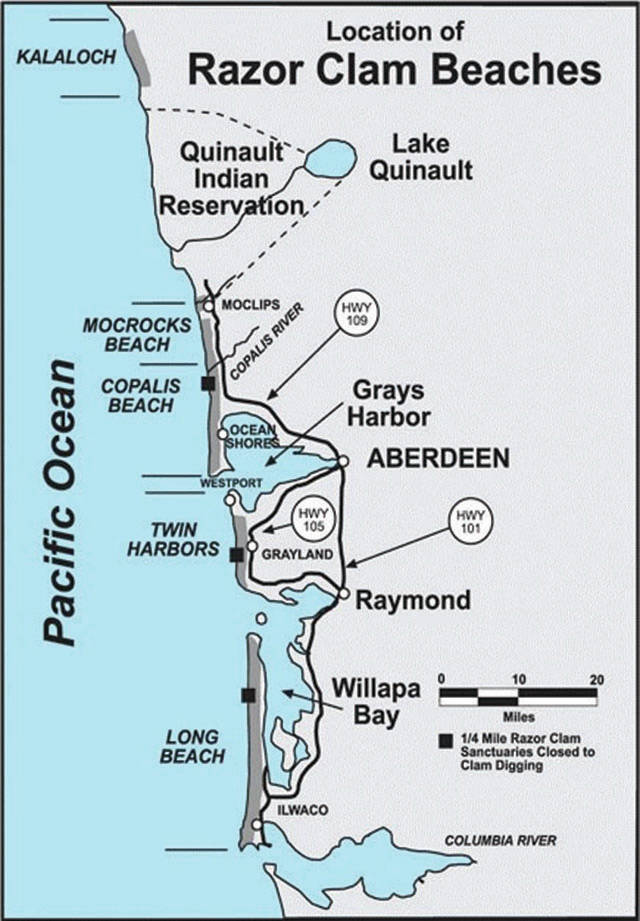State shellfish managers have approved this week’s razor clam dig set to begin on morning tides at four ocean beaches, including Long Beach, Twin Harbors, Copalis and Mocrocks.
The Washington Department of Fish and Wildlife (WDFW) approved the opening after marine toxin tests showed that clams at all four beaches are safe to eat.
Dan Ayres, WDFW coastal shellfish manager, noted that the upcoming dig marks the first time Long Beach will open for clam digging this season. Marine toxin levels at the beach had exceeded state health standards since last fall, but not anymore, Ayres said.
“We know that people have been waiting to dig razor clams at Long Beach for a long time, and we’re pleased we can finally add that beach to the line-up,” Ayres said. “Toxin levels there and at the other three beaches are all well within state health standards.”
Long Beach and Twin Harbors will both be open for five straight days of digging, while Copalis and Mocrocks will open on alternating days. All four beaches will be open on morning tides, with no digging allowed after noon.
The upcoming dig is approved on the following beaches, dates and morning low tides:
April 13, Thursday, 8:43 a.m., 0.0 feet; Twin Harbors, Copalis, Long Beach
April 14, Friday, 9:18 a.m., 0.1 feet; Twin Harbors, Mocrocks, Long Beach
April 15, Saturday, 9:55 a.m., 0.3 feet; Twin Harbors, Copalis, Long Beach
April 16, Sunday, 10:36 a.m., 0.5 feet; Twin Harbors, Mocrocks, Long Beach
All diggers age 15 or older must have an applicable 2017-18 fishing license to harvest razor clams on any beach. Licenses, ranging from a three-day razor clam license to an annual combination fishing license, are available on WDFW’s website at https://fishhunt.dfw.wa.gov and from license vendors around the state.
Ayres noted that Long Beach has also been added to a dig tentatively scheduled later this month along with the other three beaches. Final approval of that dig will depend on the results of future marine toxin tests, which generally take place about a week before the dig is scheduled.
Pending favorable test results, the proposed dig will be held on the following beaches, dates and morning low tides:
April 24, Monday, 5:38 a.m., 0.5 feet; Twin Harbors, Long Beach
April 25, Tuesday, 6:24 a.m., -0.3 feet; Twin Harbors, Long Beach
April 26, Wednesday, 7:09 a.m., -1.1 feet; Twin Harbors, Long Beach
April 27, Thursday, 7:55 a.m., -1.5 feet; Twin Harbors, Mocrocks, Long Beach
April 28, Friday, 8:42 a.m., -1.8 feet, Twin Harbors, Copalis, Long Beach
April 29, Saturday, 9:32 a.m., -1.7 feet; Twin Harbors, Mocrocks, Long Beach
April 30, Sunday, 10:24 a.m., -1.3 feet; Twin Harbors, Copalis, Long Beach
May 1, Monday, 11:20 a.m., -0.8 feet; Long Beach
For more information about future razor clam digs see WDFW’s website at http://wdfw.wa.gov/fishing/shellfish/razorclams/current.html
During all upcoming digs, state wildlife managers urge clam diggers to avoid disturbing snowy plovers and streaked horned larks. Both species nest in the soft, dry sand on the southern section of Twin Harbors beach and at Leadbetter Point on the Long Beach Peninsula. The snowy plover is a small bird with gray wings and a white breast. The lark is a small bird with a pale yellow breast and brown back. Male larks have a black mask, breast band and “horns.”
To protect these birds, the department asks that clam diggers avoid the dunes and areas of the beach with soft, dry sand. When driving to a clam-digging area, diggers should enter the beach only at designated access points and stay on the hard-packed sand near or below the high tide line.



